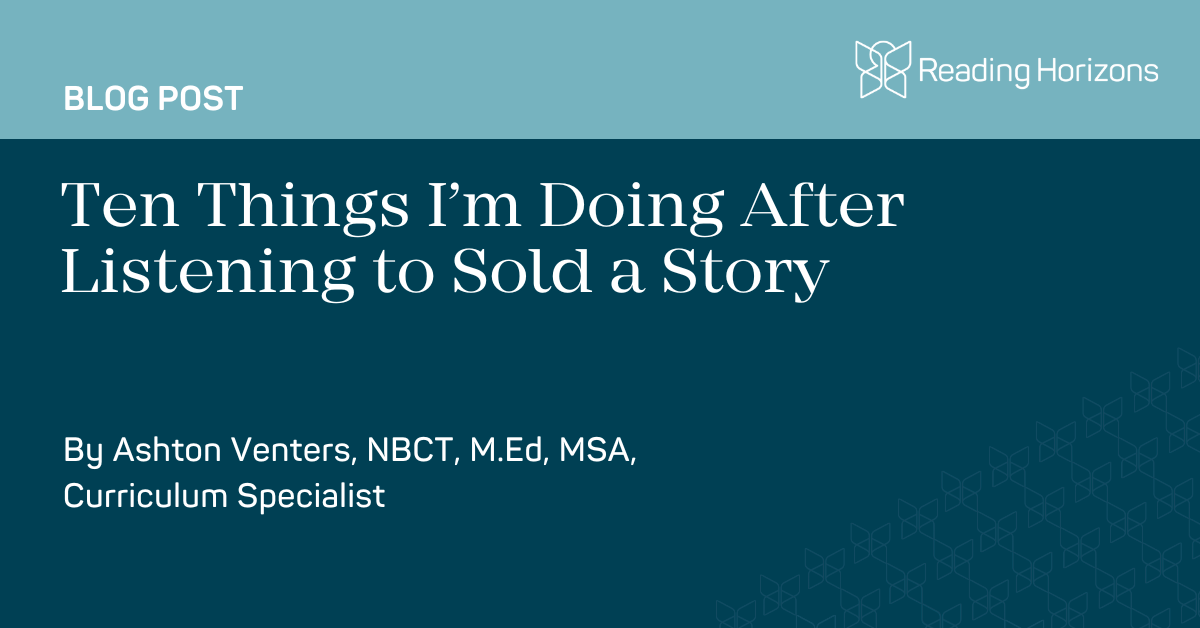By Ashton Venters, NBCT, M.Ed, MSA, Curriculum Specialist
This article was originally published on The 74.
Ashton is a Curriculum Specialist for Pitt County Schools in Greenville, North Carolina, where she has served for nearly 14 years. She is currently pursuing a Doctorate in Educational Leadership at Appalachian State University and is the President-Elect of The Reading League North Carolina.
I didn’t expect a podcast to unravel parts of my professional identity—but then I listened to Sold a Story.
What began as casual curiosity quickly became a mirror, forcing me to confront my assumptions, instructional choices, and even my complicity in how I’ve taught reading.
As I listened, I didn’t just hear a story—I heard a call to action. I found myself scribbling ideas, memories, and questions in the margins of my notebook. But more than that, I began drafting a list—not just of things I had to reckon with, but of steps I need to take now.
Here is a collection of those ten actions—steps I’m committed to taking as an educator, learner, and advocate for students—told through lived experience. Listening is only the beginning. Change comes next.
- Say goodbye to patterned texts as an indicator of reading success. Patterned books that encourage guessing instead of decoding offer false hope—to students, teachers, and families. We must replace them with authentic, diverse texts that support decoding, build knowledge, and grow a love for reading rooted in real comprehension.
- Flood schools with decodable text. We are making this happen—book by book, classroom by classroom. But it takes intention. We must provide clear, aligned resources that match our core phonics program so that instruction remains explicit and systematic. Decodables should not be an afterthought—they should be a foundation.
- Keep past students in the present. Just because students have progressed to the next grade doesn’t mean their learning gaps have disappeared. Literacy is key to unlocking so much potential—academic, emotional, and economic. How can we support middle and high schoolers, families, and adult learners who were left behind?
- Support parents and caregivers. Parents are partners in literacy. Let’s equip them with the tools they need to understand how reading works, what to look for in their child’s progress, and how to support learning at home. Resources matter. Accessibility matters. Language matters.
- Champion professional development—for all. Our responsibility doesn’t stop at students. We must continue to educate specialists, coaches, and leaders—anyone who touches instruction. Literacy is not just the job of the ELA teacher. It’s a shared responsibility.
- Prioritize science of reading training. We must invest in high-quality, evidence-aligned professional development specific to reading science. Not just one session—ongoing, job-embedded training that empowers teachers to refine their practice and advocate for what works.
- Get involved beyond the school walls. Organizations like The Reading League remind me that literacy is a movement, not just a mandate. By engaging with nonprofits, local coalitions, and national conversations, we build momentum for change far beyond our classrooms.
- Add to the research. I’m pursuing a doctorate in educational leadership through Appalachian State’s interdisciplinary cohort. My research will honor students, teachers, and families—and will contribute to a body of knowledge that is student-centered, justice-driven, and grounded in evidence.
- Focus on new teachers. We must ask: How were they taught to read? How were they trained to teach others to read? And how will they transfer that knowledge into practice? There’s no room for outdated methods or well-meaning misconceptions. Let’s start with the truth.
- Break the silence. Let’s write. Let’s explain. Let’s connect. We can’t stay quiet in the face of misinformation or misaligned instruction. Every conversation, post, and resource we share has the potential to shift hearts—and systems.
We can do better. We are doing better. But the work isn’t done. Sold a Story didn’t just reveal the gaps in reading instruction—it lit a fire in many of us to ensure this story doesn’t repeat itself.
And that fire? I plan to keep it burning.
What would you add? Find me on LinkedIn or X to keep the conversation going.

